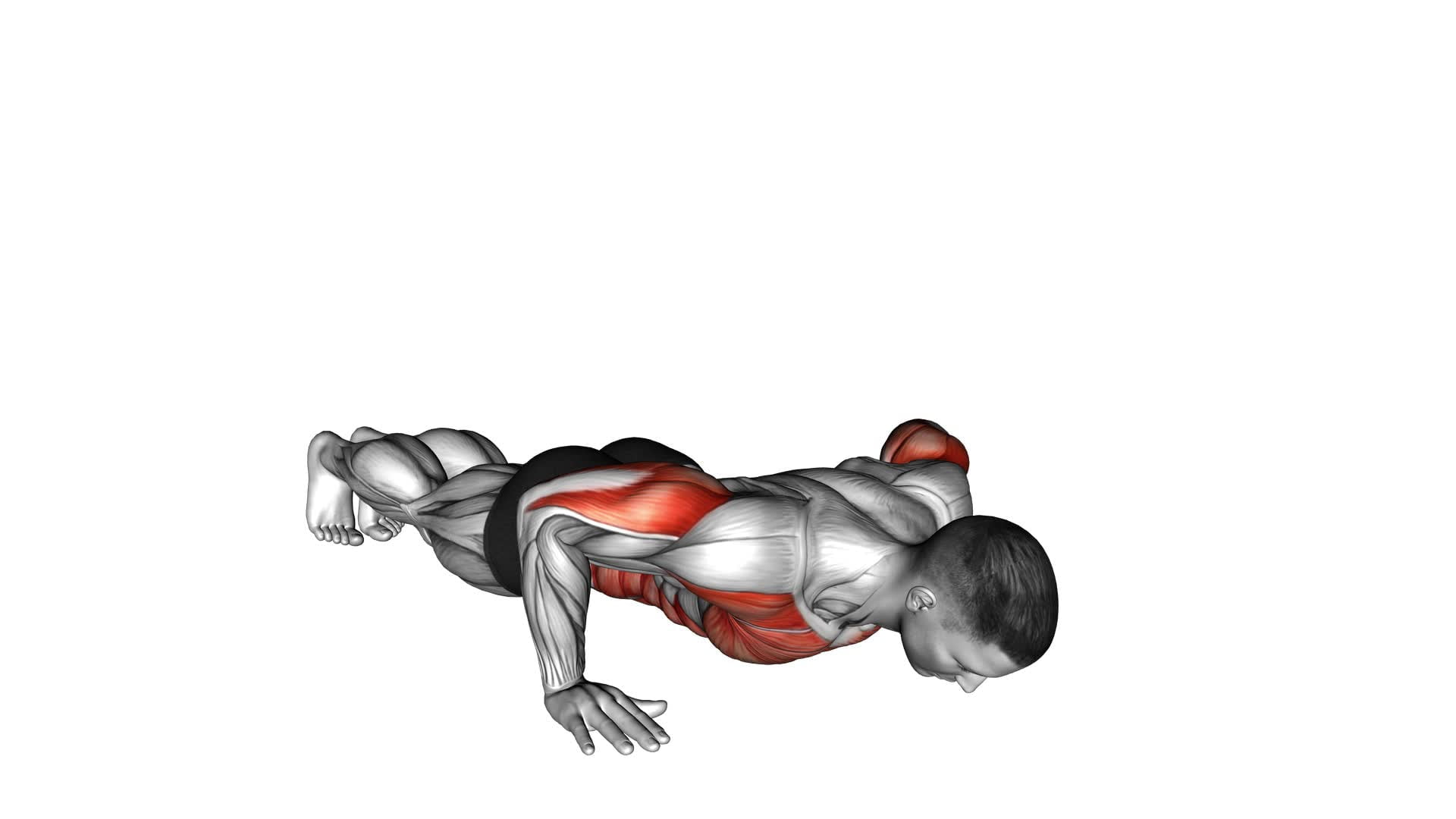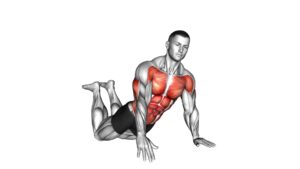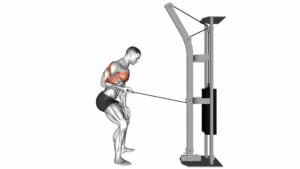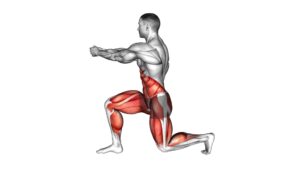Rotational Push-up – Video Exercise Guide & Tips

Are you looking to spice up your push-up routine? Look no further than the rotational push-up!
Watch This Exercise Video
This dynamic exercise not only targets your chest, shoulders, and triceps, but also engages your core and improves stability.
In this video exercise guide and tips article, we'll walk you through the proper form and technique, common mistakes to avoid, modifications for different fitness levels, and tips for increasing difficulty.
Get ready to take your push-ups to the next level with the rotational push-up!
Key Takeaways
- Rotational push-ups target the chest, shoulders, and triceps, while engaging the core and improving stability.
- Incorporating rotational movements in workouts enhances functional fitness and enhances upper body strength and stability.
- Proper form and technique include maintaining a strong and stable core, proper hand placement, and avoiding excessive twisting of the spine.
- Common mistakes to avoid include improper hand placement, lack of core engagement, and misalignment of wrists with shoulders and elbows.
Benefits of Rotational Push-ups
Discover the benefits you can gain from incorporating rotational push-ups into your workout routine.
Rotational push-ups are an excellent exercise that falls under the category of functional training. They target your upper body muscles, specifically your chest, shoulders, and arms. By adding rotation to the traditional push-up movement, you engage additional muscles in your core, including your obliques and lower back. This not only enhances your upper body strength but also improves your stability and balance.
One of the key benefits of rotational push-ups is that they promote functional training. Functional training focuses on improving the movements and strength required for daily activities. By incorporating rotational push-ups into your routine, you mimic the movements you perform in everyday life, such as pushing or reaching while twisting your torso. This helps you develop strength that translates into real-life activities, making you more efficient and less prone to injuries.
Furthermore, rotational push-ups are an effective way to challenge your upper body strength. The rotational aspect adds an extra level of difficulty compared to traditional push-ups, forcing your muscles to work harder. This increased intensity leads to greater muscle activation, helping you build stronger and more defined upper body muscles.
Incorporating rotational push-ups into your workout routine can provide numerous benefits, including functional training and improved upper body strength. So why not give them a try and experience the positive impact they can have on your fitness journey?
Proper Form and Technique
To perform rotational push-ups with proper form and technique, focus on maintaining a strong and stable core throughout the exercise. Core stability is crucial in this exercise as it helps you maintain proper alignment and control during the rotational movement.
Start by assuming a high plank position with your hands slightly wider than shoulder-width apart. As you lower your body towards the ground, engage your core muscles by drawing your belly button towards your spine. This will help you maintain a stable base and prevent any excessive twisting of the spine.
As you push back up, focus on chest activation. Imagine pushing the ground away from you and squeezing your chest muscles at the top of the movement. This won't only target your chest muscles but also help you maintain control and stability throughout the exercise.
Avoid arching your lower back or sagging your hips during the movement. Keep your body in a straight line from head to toe. If you find it challenging to maintain proper form, try modifying the exercise by performing it on your knees or using a stability ball to support your lower body.
Remember to breathe throughout the exercise and maintain a steady rhythm. By mastering proper form and technique, you can maximize the benefits of rotational push-ups and minimize the risk of injury.
Common Mistakes to Avoid
When performing the rotational push-up, it's important to avoid common mistakes that can hinder your progress.
One common mistake is improper hand placement, which can put unnecessary strain on your wrists and shoulders.
It's crucial to engage your core throughout the movement to maintain stability and prevent lower back pain.
Proper Hand Placement
Place your hands shoulder-width apart on the ground to ensure proper hand placement during the rotational push-up exercise. Proper hand placement is essential for maintaining stability and maximizing the effectiveness of the exercise.
Here are some common mistakes to avoid when it comes to hand position and wrist alignment:
- Avoid placing your hands too close together, as this can strain your wrists and limit your range of motion.
- Similarly, avoid placing your hands too wide apart, as this can shift the focus away from your chest muscles and onto your shoulders.
- Make sure your wrists are aligned with your shoulders and elbows. This will help distribute the weight evenly and reduce the risk of injury.
Core Engagement Technique
To effectively engage your core and avoid common mistakes, focus on maintaining a strong and stable midsection throughout the rotational push-up exercise. Core activation is crucial in this exercise as it helps stabilize your body and allows for proper muscle targeting.
When performing the rotational push-up, make sure to keep your abdominal muscles engaged by pulling your belly button towards your spine. This will help maintain a neutral spine position and prevent excessive arching or sagging. Avoid letting your hips sag towards the floor or lifting them too high, as this can put strain on your lower back.
Modifications for Different Fitness Levels
Now let's talk about modifications for different fitness levels.
If you're a beginner, there are simplified variations of the rotational push-up that you can try.
On the other hand, if you're more advanced, there are options to increase the difficulty of the exercise.
Additionally, it's important to remember that modifications can also be customized to suit individual needs and abilities.
Beginner Modifications: Simplified Variations
Start by performing the rotational push-up exercise on your knees to make it easier for beginners. This modified variation allows you to build strength and improve muscle activation while gradually working towards the full exercise.
Here are three simplified variations of the rotational push-up:
- Knee Push-Up: Begin in a push-up position with your knees on the ground instead of your toes. Lower your chest towards the floor, keeping your core engaged and your back straight. Push back up to the starting position.
- Incline Push-Up: Find a sturdy elevated surface, such as a bench or step. Place your hands on the surface, shoulder-width apart, and step back into a push-up position. Lower your chest towards the surface, then push back up.
- Wall Push-Up: Stand facing a wall and place your hands on the wall at shoulder height. Step back until your body is at a slight angle. Bend your elbows and lower your chest towards the wall, then push back up.
Advanced Adaptations: Increased Difficulty Options
Continue building on your progress by exploring advanced adaptations of the rotational push-up exercise, which offer increased difficulty options for individuals of different fitness levels.
One way to increase the resistance is by using a weighted vest or placing weights on your back. This added weight challenges your muscles and makes the exercise more intense.
Another advanced variation is the single-arm rotational push-up, where you perform the exercise with only one arm while the other arm is extended to the side. This requires more strength and stability to maintain proper form.
Additionally, you can elevate your feet on a bench or stability ball to create a decline position, which further engages your upper body muscles.
These advanced variations will help you continue challenging yourself and achieving new levels of strength and fitness.
Customized Adjustments: Individualized Modifications
To modify the rotational push-up for different fitness levels, customize the exercise according to your individual needs and abilities. Here are some personalized adjustments you can make to suit your fitness level:
- Knee Modification: If you're a beginner or have limited upper body strength, you can perform the rotational push-up on your knees instead of your toes. This reduces the amount of body weight you have to lift, making it easier to perform the exercise.
- Hand Placement: Adjusting the width of your hand placement can also modify the difficulty level of the rotational push-up. Placing your hands wider apart will provide more stability and make the exercise easier, while bringing your hands closer together will increase the challenge.
- Range of Motion: Depending on your flexibility and strength, you can modify the range of motion for the rotational push-up. Start with smaller rotations and gradually increase the range as you become more comfortable and stronger.
Tips for Increasing Difficulty
Challenge yourself by incorporating variations of the rotational push-up to increase difficulty. If you want to take your workout to the next level and push your limits, here are some tips for increasing the intensity of your rotational push-ups.
One way to increase the difficulty is by adding weight to your push-up. You can do this by using a weighted vest or placing weight plates on your back. This will force your muscles to work harder and help you build strength.
Another way to increase the intensity is by performing the push-up on an unstable surface. You can use a stability ball or a BOSU ball to make the exercise more challenging. This will engage your core muscles even more and improve your balance.
Additionally, you can increase the difficulty by reducing the base of support. Try performing the rotational push-up with your feet closer together or even with one foot lifted off the ground. This will require more stability and strength from your upper body.
Remember to gradually increase the difficulty of your rotational push-ups over time. This is called progressive overload and is essential for continuous improvement. Start with the modifications that feel challenging but doable, and gradually progress to more difficult variations as you get stronger.
Sample Rotational Push-up Workout Routine
Once you have mastered the basics of the rotational push-up, it's time to incorporate a sample workout routine to further enhance your strength and stability. This routine will help you improve your rotational push-up variations and reap the benefits of incorporating rotational movements in your workouts. Here is a sample workout routine to get you started:
- Warm-up: Begin with a dynamic warm-up that includes arm circles, shoulder rolls, and wrist stretches. This will prepare your upper body for the rotational movements ahead.
- Rotational Push-up with Knee Tuck: Start in a push-up position, perform a push-up, then rotate your body to the side and bring one knee towards your elbow. Alternate sides with each rep. This exercise targets your core, shoulders, and obliques.
- Rotational Push-up with Medicine Ball: Place a medicine ball under one hand and perform a push-up. As you push up, rotate your body and lift the medicine ball towards the ceiling. Repeat on the other side. This exercise adds an extra challenge to your upper body and core stability.
Remember to maintain proper form and engage your core throughout the workout. By incorporating these rotational push-up variations into your routine, you won't only build strength and stability but also improve your overall functional fitness.
Frequently Asked Questions
How Many Calories Can I Burn by Doing Rotational Push-Ups?
Rotational push-ups are an effective exercise for building upper body strength and engaging your core muscles. By incorporating proper form and technique, you can maximize the calorie burn.
The rotational movement adds an extra challenge and targets different muscle groups, increasing the intensity of the exercise. While the number of calories burned depends on various factors, such as weight and intensity, rotational push-ups can be a great addition to your workout routine for burning calories and building strength.
Can Rotational Push-Ups Help Improve My Overall Core Strength?
Rotational push-ups can definitely help improve your overall core strength. By engaging your obliques and stabilizing your body during the rotation, you're targeting and strengthening the muscles in your core.
This exercise also helps to improve balance as you twist your body from side to side. Incorporating rotational push-ups into your workout routine can be an effective way to develop a stronger and more stable core.
Are Rotational Push-Ups Suitable for Individuals With Shoulder or Wrist Injuries?
Rotational push-ups can be beneficial for shoulder rehabilitation and wrist flexibility. They engage your core muscles while also targeting the shoulders and wrists.
However, if you have shoulder or wrist injuries, it's important to consult with a healthcare professional before attempting rotational push-ups. They can assess your condition and provide guidance on whether this exercise is suitable for you or if modifications are needed to avoid further injury.
Safety should always be a priority when it comes to exercising with injuries.
How Often Should I Incorporate Rotational Push-Ups Into My Workout Routine?
To effectively incorporate rotational push-ups into your workout routine, start by doing them two to three times a week. As you become more comfortable with the exercise, you can increase the frequency.
It's important to listen to your body and give yourself enough rest between sessions.
If you're a beginner, you can start with modified variations of rotational push-ups, such as doing them on your knees or using a stability ball. This will help you build strength and gradually progress to the full exercise.
Can Rotational Push-Ups Help in Improving My Sports Performance or Specific Athletic Skills?
Rotational push-ups can greatly improve your sports performance and specific athletic skills. By incorporating these improvement techniques into your workout routine, you can enhance your core stability, upper body strength, and rotational power.
This exercise targets multiple muscle groups, including your chest, shoulders, and core, which are essential for sports movements. The benefits analysis shows that rotational push-ups can help you generate more explosive movements, increase agility, and improve overall athletic performance.
Conclusion
In conclusion, rotational push-ups are a highly effective exercise that targets multiple muscle groups, including the chest, arms, and core. By incorporating rotation into the movement, you can engage your obliques and improve overall stability and strength.
It's important to maintain proper form and technique to maximize the benefits and avoid common mistakes. Additionally, there are modifications available for different fitness levels and ways to increase the difficulty as you progress.
Incorporating rotational push-ups into your workout routine can help you achieve a stronger and more toned upper body.

Author
Years ago, the spark of my life’s passion ignited in my mind the moment I stepped into the local gym for the first time. The inaugural bead of perspiration, the initial endeavor, the very first surge of endorphins, and a sense of pride that washed over me post-workout marked the beginning of my deep-seated interest in strength sports, fitness, and sports nutrition. This very curiosity blossomed rapidly into a profound fascination, propelling me to earn a Master’s degree in Physical Education from the Academy of Physical Education in Krakow, followed by a Sports Manager diploma from the Jagiellonian University. My journey of growth led me to gain more specialized qualifications, such as being a certified personal trainer with a focus on sports dietetics, a lifeguard, and an instructor for wellness and corrective gymnastics. Theoretical knowledge paired seamlessly with practical experience, reinforcing my belief that the transformation of individuals under my guidance was also a reflection of my personal growth. This belief holds true even today. Each day, I strive to push the boundaries and explore new realms. These realms gently elevate me to greater heights. The unique combination of passion for my field and the continuous quest for growth fuels my drive to break new ground.







